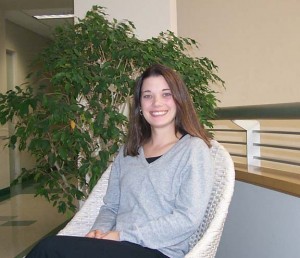By Matt Sinclair ’90
Ixempra, a medicine used to treat breast cancer, and Baraclude, used to combat chronic hepatitis B infection, were developed by a team of scientists at Bristol-Myers Squibb that now includes Holly Baseski Shackman ’00. Although not involved in the research and development of Ixempra, she has worked on several projects involving Baraclude since its release in 2007.

Holly Baseski Shackman '00 at Bristol-Myers Squibb
A research investigator in the analytical and bioanalytical development division at Bristol-Myers Squibb, New Brunswick, N.J., Shackman develops pharmaceuticals to help manage diseases and change lives. Although not at liberty to discuss the specifics of her work, she can say that the company targets certain disease areas, and has several products in oncology and neuroscience on the market.
Shackman works on drugs that have potential and are in “early stage development,” which means they are either about to enter, or have just entered clinical trials. “The work constantly changes, and it all depends on what projects are coming through the pipeline at the time and what point of development they have reached,” she says.
Like many science majors at Lafayette, Shackman initially thought she was going to become an engineer, specifically a chemical engineer. “Once I discovered exactly what a chemical engineer does,” she says, “I realized that what really interested me was the chemistry itself.” She graduated with a B.S. in chemistry and a minor in mathematics.
While pursuing a Ph.D. in analytical chemistry at University of Michigan, Shackman honed her instrumental expertise, specifically in liquid chromatography and mass spectrometry. Now, at BMS, when one project requires her specific skills, others might be placed on the back burner for a short time. “Everyone knows each other within our group as well as their strengths and specialties,” she explains. “We discuss the difficulties regarding the projects that we are working on with one another. There is a lot of interaction and cooperation.”
But even with the high degree of collaboration, in a sense, her work can be rather lonely. Her husband, an analytical chemist for BMS, doesn’t understand all the nuances of what she does, though they are able to discuss research challenges that might arise. “We use different types of instruments and detectors,” she says. “But we’ll have conversations such as ‘What kind of additive did you use?’ It’s nice to have that person who can act as a sounding board and understand the challenges and frustrations.”
Shackman remains in touch with Chip Nataro, associate professor of chemistry at Lafayette, with whom she co-authored a paper in 2001, even though their fields are different now: he specializes in inorganic chemistry, while she focuses on analytical chemistry. “Every now and then he’ll have a question that’s more analytical in nature,” she says. “But our research interests are almost as different as comparing chemistry to physics.”
When asked about how she responds to people who question the price of pharmaceuticals, Shackman says that people would be less likely to complain if they understood the process that goes into bringing a single drug to market. “You’re not paying for a single pill,” she explains. “Each drug starts off as one of maybe 10,000 possibilities, which gets cut down to a thousand, then to a hundred. And then the drugs go into clinical trials. Maybe only one of the original 10,000 makes it through the entire process and onto the market.”
Scientists can’t predict everything that will happen with a drug during development, she says. A lot of information is gained along the way that can be used for future drugs, but some of the costs incurred for those that don’t make it to market are incorporated into those that do.
“I know that by conducting experiments on drugs that I can have a direct role in helping someone with a serious disease,” says Shackman. “To know that I can have that kind of impact is fulfilling and makes me happy.”
